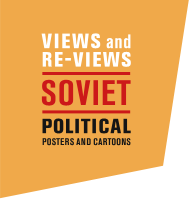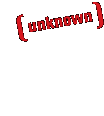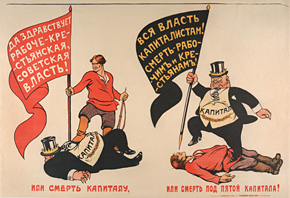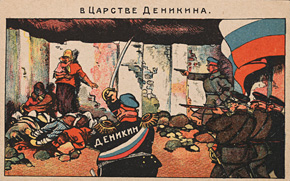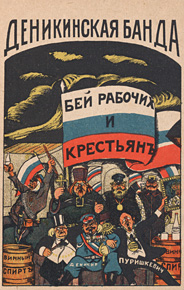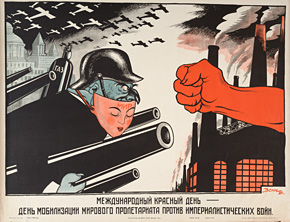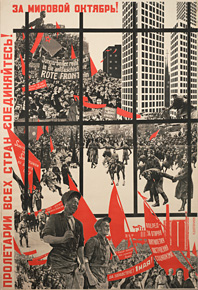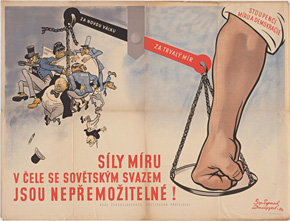

MIKHAIL BALJASNIJ | BRIGADE KGK3 | MIKHAIL CHEREMNYKH | NIKOLAI CHOMOV | VIKTOR DENI | NIKOLAI DOLGORUKOV | BORIS EFIMOV | VLADIMIR GALB | IULII GANF | VERA GITSEVICH | František Gross
In the captions artists' titles are in italics, descriptive titles are in roman, and inscriptions taken from the artwork are in quotation marks.
Dimensions are in inches.

MIKHAIL CHEREMNYKH and VLADIMIR MAYAKOVSKY
Russian: 1890-1962 and 1893-1930, respectively
ROSTA Window series #81
March 1921
All for Farming Equipment Repair Week!
Hand-cut stencils with watercolor pigment
20½ x 13½ to 21¼ x 14¼ each

NIKOLAI CHOMOV and IURII MERKULOV
Ukrainian 1903-1974, and Unknown, respectively
"Fulfill the five-year plan not in five years, but in four"
1930
Lithograph
21¾ x 13½
VIKTOR DENI
Viktor Deni and Dmitri Moor began their careers as cartoonists during the Revolution and went on to become the major poster artists of the Bolshevik period (1917-1921). Deni was above all a satirist, and his artistic style was well established before the October Revolution.
Wildly clever imagery and scathing text characterize his bitingly satirical posters and cartoons, leaving no question as to who was friend and who was foe in Civil War Russia. Devoted to the Bolshevik cause, Deni lionized the strong factory worker and noble collective farmer and demonized the capitalist, imperialist, Tsar, kulak, priest, and White Army general. Heroes are portrayed with red fists raised in service of the collective while enemies are shown as grotesquely fat, wealthy, and uncaring or as savage beasts concealed by a friendly mask.
Born in Moscow as Viktor Denisov in 1893, he later shortened his name to Deni. A year before the outbreak of World War I, he moved to St. Petersburg and was immediately successful, his caricatures appearing in several illustrated satirical journals. Deni worked under the Litizdat (the state publishing house) after the October Revolution and dedicated himself to the new Russia. He composed nearly 50 posters during the Civil War, including some of his most well known satirical work, such as "Death to capital — or death under the heel of capital" and "The Denikin Gang" both included in the exhibition. In the later 1920s and 1930s, Deni shifted his focus to newspaper cartoons with foreign policy themes. Although he returned briefly to the medium of the political poster during World War II, he died shortly thereafter, in 1946.

VIKTOR DENI
Russian, 1893-1946
"The Denikin Gang: Beat the workers and peasants"
after a poster dated 1919
Offset lithograph
5½ x 3½
"The League of Nations: Capitalists of all counties, unite!"
after a poster dated 1919
Offset lithograph
5½ x 3½
"Bread power. Kulak-bloodsucker: What do I care about the hungry?!"
after a poster dated 1921
Offset lithograph
5¾ x 4¼
"International Red Day — The day to mobilize the proletariat of the world against the armies of imperialism"
1929
Lithograph
20½ x 26¾

NIKOLAI DOLGORUKOV
Russian, 1902-1980

BORIS EFIMOV
Russian, 1900-
"A True Aryan Should Be: Tall (Goebbels), Muscular and Slim (Goering), Blonde (Hitler)"
1941
Ink, watercolor, pencil on cardboard
19 x 14¼

Brigade KGK3
(VERA GITSEVICH, VIKTOR KORETSKY,
and BORIS KNOBLOK)
Russian 1897-1976, Ukrainian 1909-1998, and Unknown, respectively
"Long live International Women's Day"
c. 1930
Lithograph
36¾ x 23
















